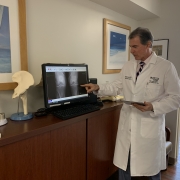Knee Replacement Surgery in Younger Patients
There has been much discussion in the medical community about partial and total knee replacement surgery in younger patients. Long used to treat severe arthritis in the elderly, knee replacement surgery for those aged 45 to 54, who cannot find relief with more conservative treatments, is projected to increase to nearly one million procedures by 2030.
One of the primary concerns for performing knee replacement surgery in younger patients is the longevity of the implant. While new and evolving prosthetic components are being designed to compensate for wear and tear, just as with a real knee joint, the amount of activity directly correlates to the life of an artificial joint. Also critical for maximal longevity with a partial or total knee replacement, is that the components be optimally implanted. If a person develops an angular deformity from arthritis, it needs to be corrected so that neutral alignment is achieved. After surgery, the knee should look straight, i.e., if a weighed line were dropped from the center of the hip joint, it should bisect the middle of the knee and the middle of the ankle. Also critical is that the soft tissues are balanced throughout the range of motion. These are the knees that last the longest and feel the best, in spite of the patient’s weight or activity level.
When we see younger patients at the Leone Center for Orthopedic Care, one of the major criteria for determining the best procedure is how the deteriorated joint is affecting someone’s lifestyle. If a patient cannot participate in regular physical activity, having a partial or total knee replacement may outweigh the concerns of implant longevity for several important reasons, especially for patients who have become inactive due to pain. Inactivity can lead to even more serious health problems such as major weight gain, loss of cardiovascular fitness and depression. Patients often tell me they feel frustrated and inactive and just want their quality of life back.
The activities of many younger patients, such as jogging and high-impact sports, can cause earlier onset of arthritis and joint deterioration. This has created a Catch 22 for orthopedic surgeons, as often people wish to return to these activities.
Returning to sports after knee replacement surgery is assessed on an individual basis, depending on the outcome of each patient. It is highly recommended that you discuss all plans with your surgeon.
Younger patients who have had joint replacements should use judgment when returning to high-impact sports. I’ve learned that after receiving a total or partial knee replacement, most of my patients do return to whatever sports and activities they are passionate about. If they are determined, some even return to more aggressive sports such as baseball, downhill skiing, tennis, squash, hockey and more. I strongly recommend against a lot of long-distance jogging and heavy weight lifting with their legs.
As with any surgery, the goal at the Leone Center is to improve the quality of life for our patients and provide the best outcomes for joint replacement surgery. I have earned a reputation as one of the nation’s top orthopedic surgeons, having performed thousands of successful surgeries during my 20-year career.
If you have severe, never-ending joint pain that is preventing you from living your life to the fullest, talk to your surgeon and find out what options are best for you.
We thank you for your readership. If you would like a personal consultation, please contact our office at 954-489-4575 or by email at LeoneCenter@Holy-cross.com.











